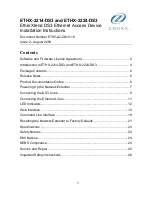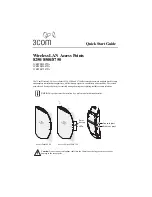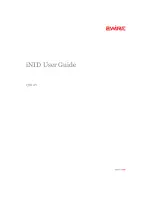
Transition Networks, Inc.
S4224 Web User Guide
33595 Rev. C
Page 659 of 669
RDI
RDI (Remote Defect Indication) is an OAM function used by a MEP to indicate a defect detected to the remote
peer MEP. The IEEE Remote Defect Indication (RDI) is a single bit carried by the CCM. The absence of RDI in
a CCM indicates that the transmitting MEP is receiving CCMs from all configured MEPs.
A MEP can use ITU-T ETH-RDI to notify its peer MEPs that it detects a defect condition. ETH-RDI is used only
if ETH-CC transmission is enabled. ETH-RDI is used in single-ended fault management and in contributing to
far-end performance monitoring. A MEP in a defect condition transmits frames with ETH-RDI information. When
a MEP receives frames with ETH-RDI information it determines that its peer MEP has encountered a defect
condition
A MEP, on detecting a defect condition with its peer MEP, sets the RDI field in the CCM frames for the duration
of the defect condition. CCM frames are transmitted periodically based on the CCM transmission period when
the MEP is enabled for CCM frames transmission. When the defect condition clears, the MEP clears the RDI
field in the CCM frames in subsequent transmissions.
Reversion Time (WTR time)
In revertive mode, the Reversion Time is the difference between the repair instant of the original resource and
the Reversion Instant.
Revertive Mode
Protection is in revertive mode if, after a resource failure and its subsequent repair, the network automatically
reverts to using this initial resource. The protection is in non-revertive mode otherwise. Automatic reversion may
include a reversion timer (i.e., the Wait To Restore), which delays the time of reversion after the repair.
In Revertive mode of unidirectional protection switching operation, in conditions where working traffic is being
received via the protection entity, if local protection switching requests have been previously active and now
become inactive, a local wait-to-restore state is entered. Since this state now represents the highest priority
local request, it is indicated on the transmitted "request/state" information and maintains the switch. With
bidirectional protection switching, a local wait-to-restore state is entered only when there is no higher priority of
request received from the far end than that of the wait-to-restore state. This state normally times out and
becomes a no request state after the wait-to-restore timer has expired. The wait-to-restore timer is deactivated
earlier if any local request of higher priority pre-empts this state. A switch to the protection entity may be
maintained by a local wait-to-restore state or by a remote request (wait-to-restore or other) received via the
"request/state" information. So, in a case
where a bidirectional failure for a working entity has occurred and subsequent repair has taken place, the
bidirectional reversion back to the working entity does not take place until both wait-to-restore timers at both
ends have expired. See also “Non-revertive mode”.
Ring MEL
The Maintenance Entity Group (MEG) Level providing a communication channel for ring automatic protection
switching (R-APS) information. From ITU-T Rec.G.8032/Y.1344 (03/2010).
Ring Protection Link (RPL)
The ring link that under normal conditions, i.e., without any failure or request, is blocked (at one or both ends)
for traffic channel, to prevent the formation of loops. From ITU-T Rec.G.8032/Y.1344 (03/2010).
RPL Neighbour node
The RPL neighbour node, when configured, is an Ethernet ring node adjacent to the RPL that is responsible for
blocking its end of the RPL under normal conditions (i.e., the ring is established and no requests are present in
the ring) in addition to the block by the RPL owner node. However, it is not responsible for activating the
reversion behaviour. From ITU-T Rec.G.8032/Y.1344 (03/2010). Contrast “RPL Owner Node”.
RPL Owner node
The RPL owner node is an Ethernet ring node adjacent to the RPL that is responsible for blocking its end of the
RPL under normal conditions (i.e., the ring is established and no requests are present in the ring). Furthermore,
it is responsible for activating reversion behaviour from protected or manual switch/forced switch (MS/FS)
conditions.
From
ITU-T Rec.G.8032/Y.1344 (03/2010). Contrast “RPL Neighbor Node”.
Router
In IPv6, a node that forwards IPv6 packets not explicitly addressed to itself.











































